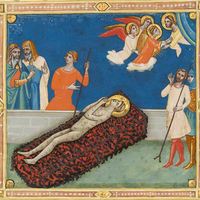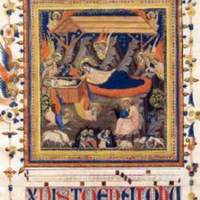Tuscany : The Laudario of Sant'Agnese
In 1248 the confraternity known as the Compagnia di Sant’Agnese, belonging to the Church of Santa Maria, was formed. This group of pious laypeople was responsible for producing the Laudario of Sant’Agnese, the most elaborate illuminated manuscript from the Trecento. No expense was spared in constructing these folios, decorated by esteemed artists Pacino di Bonaguida and the Master of the Dominican Effigies.
While there are twenty-eight illuminations from the Laudario of Sant’Agnese still in existance, the Martyrdom of St. Lawrence by Pacino Bonaguida and the Nativity and Annunciation to the Shepherds by the Master of the Dominican Effigies express the most important details of the entire work. Each is similarly styled, with dark backgrounds, weighty Giotto-inspired figures and gold leaf detailing. These full-page illuminations were costly commissions but also reminders of the type of piety people of the Trecento believed they needed to be in order to survive the plague of 1348.
In the first half of the fourteenth century the middle class in Florence boomed. Merchants, tradesmen, and shopkeepers alike grew in size and power, effectively taking economic control away from the nobility. With their newfound economic independence men (and women) formed confraternities and collectively commissioned building, artworks and illuminated manuscripts It was the elaboration of this functional object that was important to evidence one’s social status. When the Black Death struck Florence in 1348, devastation and despair spread even more quickly than disease. People were dying so rapidly that often, funerary rights could not be performed. More than ever, churches emphasized the importance of leading a pious life and referring to the prayer-songs from the Laudario of Sant’Agnese was a way of doing this.


